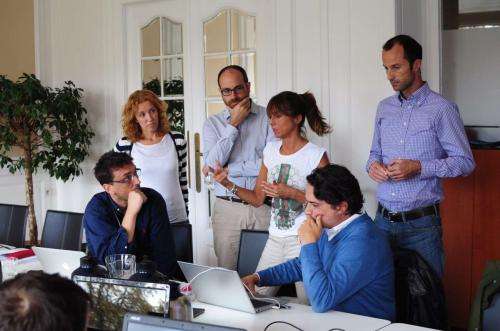Internet of things should be developable for all

Within the next five to ten years, around 100 billion different devices will be online. A large part of the communication takes place solely between machines, and to ensure that they can communicate, the European Commission has supported a project that over the last three years has been working on creating a common platform – a programming language, that can make everything from microwave ovens to wind meters talk to each other.
Telephones. Refrigerators. Cars. Television sets. Bathroom scales. More and more of the things that surround us in our daily lives send and receive data via the Internet without us having to know about it. The phenomenon is called the "Internet of Things". During the last three years, Aalborg University has been involved in a major European project to ensure that the things speak the same language – and that the language can be used by all.
The Internet is growing. Not only in in terms of the people that use it, but also when it comes to the number of different devices that are online. These are not reduced to smartphones, computers and laptops either, but include practically everything containing modern day electronics. Recently, car manufacturer Tesla announced that from now on their cars will be online all the time and receive software updates that will improve the cars' performance without the owners having to take the cars to be serviced by a mechanic. All they have to do is push a button to confirm that their automobile is now faster than before, contains an updated GPS map database or an improved speed pilot.
Realistically, within the next five to ten years, around 100 billion different devices will be online. A large part of the communication takes place solely between machines, and to ensure that they can communicate, the European Commission has supported a project that over the last three years has been working on creating a common platform – a programming language, that can make everything from microwave ovens to wind meters talk to each other.
Invisible, but clever
Millions of units are already connected to the Internet today without us necessarily being aware of it. And even data from ordinary consumer electronics can be valuable if it is shared via the Internet and used appropriately.
If information about temperature, air humidity, wind speed etc. from all the weather stations in private homes were made available to other machines online, the data gathered would make it possible to produce even more accurate weather forecasts than meteorologists do today.
The gain is to narrow the gap between the virtual and the physical world and to ensure that the information exchanged is stable and free of errors.
Open for everyone
One of the most important prerequisites for creating a functioning platform is that it must be available for everyone and free to use—something in computer lingo known as "open source".
"It is important to work with open source programming and make the programming platform available for everyone who wants to download it," says Sofoklis Kyriazakos from the Center for TeleInfrastructure (CTIF) at Aalborg University, who has been project manager on the development work.
"We would like people to use it, build on it and ensure that it is disseminated. The more programmers that use it the better it becomes. To put it simply, we are involving the users in the innovation. It's a win-win situation.
"By creating an open platform, it becomes faster and less expensive for manufacturers to develop products that can communicate. When the basic functions in the software have already been made available, developers and manufacturers can focus on getting their specific data to flow in the right way rather than having to reinvent the wheel."
Discover the latest in science, tech, and space with over 100,000 subscribers who rely on Phys.org for daily insights. Sign up for our free newsletter and get updates on breakthroughs, innovations, and research that matter—daily or weekly.
Ready, steady, use!
The project that has developed the system called BETaaS began in the fall of 2012 and last year presented its open source software that has thus far been tested in two different scenarios—one in a private home setting where the software platform was used to control a garden watering system based on data from other devices.
BETaaS has also been tested on a larger, smart city infrastructure where the surroundings help the city's population with everything from finding vacant parking spots, accessing public transport, booking hotel rooms and attractions, car sharing and activating street lamps.
Professor Ramjee Prasad, Director of the Center for TeleInfrastructure at Aalborg University, sees grand perspectives in the Internet of Things in the future.
"It will change the way we live and work," he says. "Consumers will enjoy a large number of innovative services, while from a business perspective we can generate value by exploiting Internet-connected objects for the creation of innovative applications."
Provided by Aalborg University


















